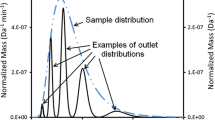Abstract
Progress in theory of separation mechanisms controlling the Micro-Thermal Field-Flow Fractionation of the macromolecular and particulate species inspired the development of the experimental methodology and instrumental techniques. Three really functioning separation mechanisms are polarization, steric and focusing. However, steric mechanism is rather exceptionally operative for the separation of large particles at low flow rates of the carrier liquid. On the other hand, two modus operandi taking advantage of focusing mechanism emerging at high flow rates and, consequently, resulting in very rapid separations are elaborated. One exploits the action of the lift force and the other one makes use of the kinetic energy generated by the collisions among the particles in bi-disperse suspension of the particulate species. Surface properties and their topographical heterogeneity influence the migration of particulate species exposed to the force of thermal diffusion. The shape of the spherical versus non-spherical particles distinguishes their behavior when exposed to thermal diffusion and to hydrodynamic stress. It was theoretically calculated that the separations of the particles, based on the mentioned differences, are possible by Focusing Micro-Thermal Field-Flow Fractionation. Since our earlier theoretical models were not developed in sufficient details, some of the previous results are corrected by the present paper. The theoretical conclusions are supported by preceding real separations.









Similar content being viewed by others
Data availability
The author declares that the data supporting the findings of this study are available within the paper or in the cited References. The datasets generated during the current study are available from the author on reasonable request.
References
Janča J (1982) Makromol Chem Rapid Commun 3:887–890
Janča J (1983) Makromol Chem Rapid Commun 4:267
Giddings JC (1983) Sep Sci Technol 18:765–773
Svensson H (1961) Acta Chem Scand 15:325–341
Svedberg T, Pedersen KO (1940) The ultracentrifuge. Clarendon Press, Oxford
Kolin A (1977). In: Radola BJ, Graesslin D (eds) Electrofocusing and isotachophoresis. de Gruyter, Berlin
Janča J (2008) Microthermal field-flow fractionation. analysis of synthetic, natural, and biological macromolecules and particles. HNB Publishing, New York, ISBN: 978-0-9728061-5-2
Kondepudi D, Prigogine I (1998) Modern thermodynamics. From heat engines to dissipative structures. Wiley, Chichester, ISBN: 0 471 97394 7
Janča J, Berneron JF, Stejskal J (2010) Int J Polym Anal Charact 15:536–543
Poiseuille JLM (1836) Ann Sci Nat 5:111–115
Segré G, Silberberg A (1961) Nature 189:209–210
Saffman PG (1956) J Fluid Mech 22:385–400 (Corrigendum: J Fluid Mech 1968, 31, 624)
Williams PS, Koch T, Giddings JC (1992) Chem Eng Commun 111:121–147
Landau LD, Lifschitz EM (1986) Hydrodynamics. Nauka, Moscow (in Russian)
Stokes G (1880) Mathematical and physical papers. Cambridge University Press, New York
Einstein A (1906) Ann Phys 19:371–381
Sharp DH (1984) Phys D 12:3–18
Mathematica, registered trademark of Wolfram Research, Inc.
Janča J, Stejskal J (2009) J Chromatogr A 1216:9071–9080
Janča J (1987) Field-Flow Fractionation: Analysis of Macromolecules and Particles, Chromatogr Sci Ser, vol 39. Marcel Dekker Inc., New York
Schimpf ME, Caldwell KD, Giddings JC (2000) Field-flow fractionation handbook. Wiley, New York
Perrin F (1936) J Phys Radium 7:1–11
Janča J, Kašpárková V, Halabalová V, Šimek L, Růžička J, Barošová E (2007) J Chromatogr B 852:512–518
Kašpárková V, Halabalová V, Šimek L, Růžička J, Janča J (2007) J Biochem Biophys Methods 70:685–687
Janča J, Audebert R (1993) J Appl Polym Sci 52:63–78
Janča J (2000) Phys Chem Chem Phys 2:2607–2611
Clausius RJE (1858) Ann Phys 105:239–258
Janča J, Audebert R (1993) Microchim Acta 111:163–175
Meselson M, Stahl FW, Vinograd J (1957) Proc Natl Acad Sci USA 43:581–588
Janča J, Špírková M, Stejskal J (2003) Russ J Phys Chem 77(Suppl 1):S95–S104
Author information
Authors and Affiliations
Contributions
I am the sole author of the submitted paper
Corresponding author
Ethics declarations
Competing interests
The authors declare no competing interests.
Additional information
Publisher's Note
Springer Nature remains neutral with regard to jurisdictional claims in published maps and institutional affiliations.
Rights and permissions
Springer Nature or its licensor (e.g. a society or other partner) holds exclusive rights to this article under a publishing agreement with the author(s) or other rightsholder(s); author self-archiving of the accepted manuscript version of this article is solely governed by the terms of such publishing agreement and applicable law.
About this article
Cite this article
Janča, J. Focusing Mechanisms in Micro-thermal Field-Flow Fractionation. Chromatographia 87, 259–268 (2024). https://doi.org/10.1007/s10337-024-04316-0
Received:
Revised:
Accepted:
Published:
Issue Date:
DOI: https://doi.org/10.1007/s10337-024-04316-0




